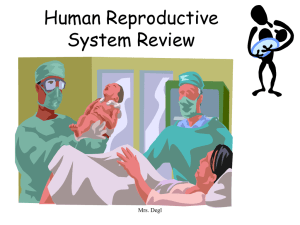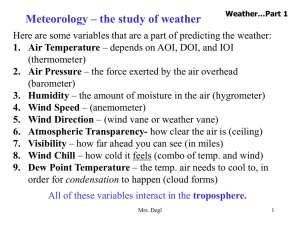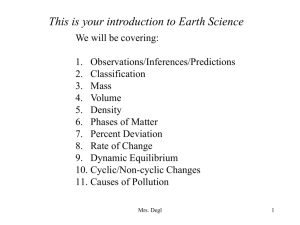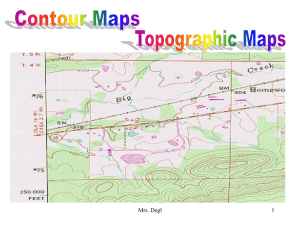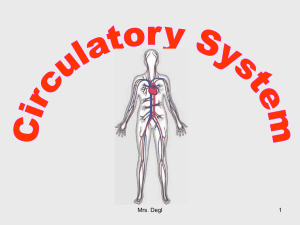Modern Evolution
advertisement
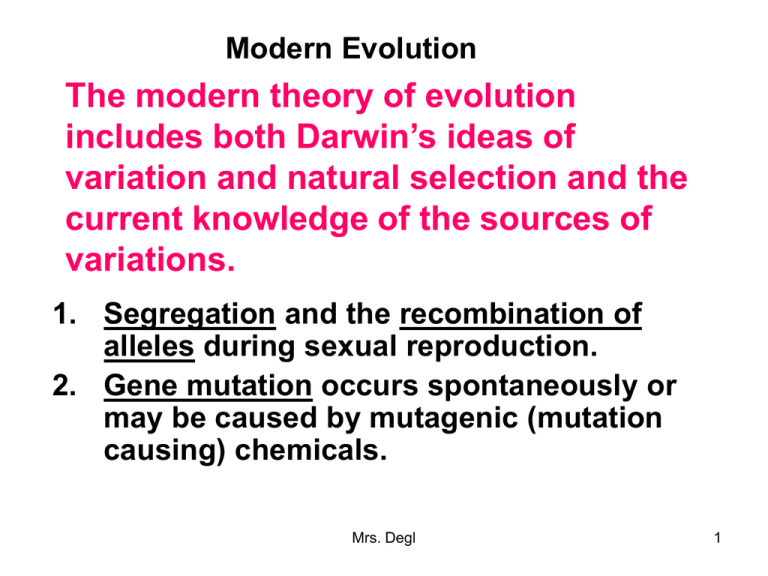
Modern Evolution The modern theory of evolution includes both Darwin’s ideas of variation and natural selection and the current knowledge of the sources of variations. 1. Segregation and the recombination of alleles during sexual reproduction. 2. Gene mutation occurs spontaneously or may be caused by mutagenic (mutation causing) chemicals. Mrs. Degl 1 Natural Selection • Natural selection involves the struggle of organisms to survive and reproduce in a given environment • Traits which are beneficial to the survival of an organism tend to be retained and passed on, and therefore, increase in frequency within a population • Traits which have low survival value to an organism tend to diminish in frequency from generation to generation. These are selected against. • If environmental conditions change, traits that have low survival value may now have a greater survival value. Therefore, traits that prove to be favorable under new environmental conditions will increase in frequency Mrs. Degl 2 Geographic Isolation 1. Isolation of a population increases the chances for speciation (the development of a new species) by separating a small group of organisms from the main population with its large gene pool (inheritable traits) 2. Changes in gene frequency are more likely to occur in small populations than in large ones 3. Geographic isolation of a population is caused by natural barriers like mountains, large bodies of water, and deserts Mrs. Degl 3 4. The evolution of an isolated population into a new species may involve the following factors: a) the gene frequency in the isolated population may have been different than the gene frequency in the main population to begin with (founder effect) b) different mutations occur in the isolated population and in the main population c) different environmental factors may also have exerted different selection pressures on each population (natural selection was different) Mrs. Degl 4 Reproductive Isolation •If the isolated population becomes so different from the main population that members of the two cannot interbreed, even if the geographic barriers are removed. •When two populations can no longer interbreed and produce fertile offspring, they have become two distinct species. Mrs. Degl 5 Time Frame for Evolution Gradualism- proposes that evolutionary change is slow, gradual, and continuous Punctuated Equilibrium- proposes that species have long periods of stability (several million years) interrupted by geologically brief periods of significant change during which a new species may evolve. This could be caused by drastic environmental changes, such as global cooling or warming. Environmental changes such as these could also cause an extinction. Mrs. Degl 6 Heterotroph Hypothesis •This is one proposed explanation for how life arose and evolved on primitive earth. •According to the Heterotroph Hypothesis, the first life forms were heterotrophic and had to obtain their nutrients from the environment. Mrs. Degl 7 Primitive Earth •Earth was very hot consisting of inorganic substances in all states: solid, liquid, and gas. And the land was still forming from cooling lava. •The atmosphere consisted of water vapor, hydrogen, methane gas, and ammonia (No Oxygen) •As the earth cooled, water vapor condensed in the atmosphere and rain fell forming seas described as “hot, thin soup”, full of dissolved minerals from the land. •In addition to the extreme heat, there was electrical energy in the atmosphere causing lightning, radiation from the Sun (because of the lack of an established atmosphere), and radioactive gasses being given off from radioactive rocks cooling. Mrs. Degl 8 Synthesis of Organic Compounds •The inorganic molecules in the seas chemically bonded to form organic molecules, including simple sugars and amino acids. •These organic molecules became the building blocks for the first life forms. •Scientist Stanley Miller created an apparatus that simulated the conditions on the early Earth. His experiments showed that dissolved gasses could combine to form simple organic compounds, in the presence of heat and electrical energy. Mrs. Degl 9 Mrs. Degl 10 • Some of the large complex molecules formed groupings or clusters called aggregates • These aggregates developed a surrounding “membrane” • It is believed that aggregates absorbed simple organic molecules from the environment for food • Therefore, they carried on a form of heterotrophic nutrition • Over time, the aggregates became more complex and highly organized. • Eventually they developed the ability to reproduce and were therefore considered “living cells” Mrs. Degl 11 • It is thought that these early heterotrophic life forms carried on a form of anaerobic respiration known as fermentation • As a result of the extended periods of fermentation, carbon dioxide was added to the atmosphere • Eventually, as a result of evolution, some heterotrophic forms developed the capacity to use carbon dioxide from the atmosphere to form organic compounds (food) • These organisms were the first autotrophs • Some bacteria are autotrophs, but most of the autotrophs today are green plants and algae. Mrs. Degl 12 Anaerobes to Aerobes •Photosynthesis from the autotrophs added oxygen molecules to the atmosphere. Eventually the atmosphere was filled with O2. •Over time, both autotrophs and heterotrophs evolved the ability to use oxygen for respiration (became aerobic, instead of anaerobic), because it was more efficient than what they were doing. •There are both heterotrophic and autotrophic (plants) organisms on the Earth today. •Presently, most life forms use aerobic respiration today, although there are still some anaerobic organisms around. Mrs. Degl 13 3 Modern theories of continuous evolution Divergent Evolution, Convergent Evolution, and Parallel Evolution. All of them seem to occur at different times. Mrs. Degl 14 Divergent evolution - Pattern of evolution in which two closely related species gradually become more and more dissimilar. When people hear the word "evolution," they most commonly think of divergent evolution, the evolutionary pattern in which two species gradually become increasingly different. This type of evolution often occurs when closely related species diversify to new habitats. On a large scale, divergent evolution is responsible for the creation of the current diversity of life on earth from the first living cells. On a smaller scale, it is responsible for the evolution of humans and apes from a common primate ancestor. Mrs. Degl 15 Convergent Evolution Convergent evolution causes difficulties in fields of study such as comparative anatomy. Convergent evolution takes place when species of different ancestry begin to share analogous traits because of a shared environment or other selection pressure. For example, whales and fish have some similar characteristics since both had to evolve methods of moving through the same medium: water. Mrs. Degl 16 Parallel Evolution Parallel evolution occurs when two species evolve independently of each other, maintaining the same level of similarity. Parallel evolution usually occurs between unrelated species that do not occupy the same or similar niches in a given habitat. Mrs. Degl 17 Mrs. Degl 18
